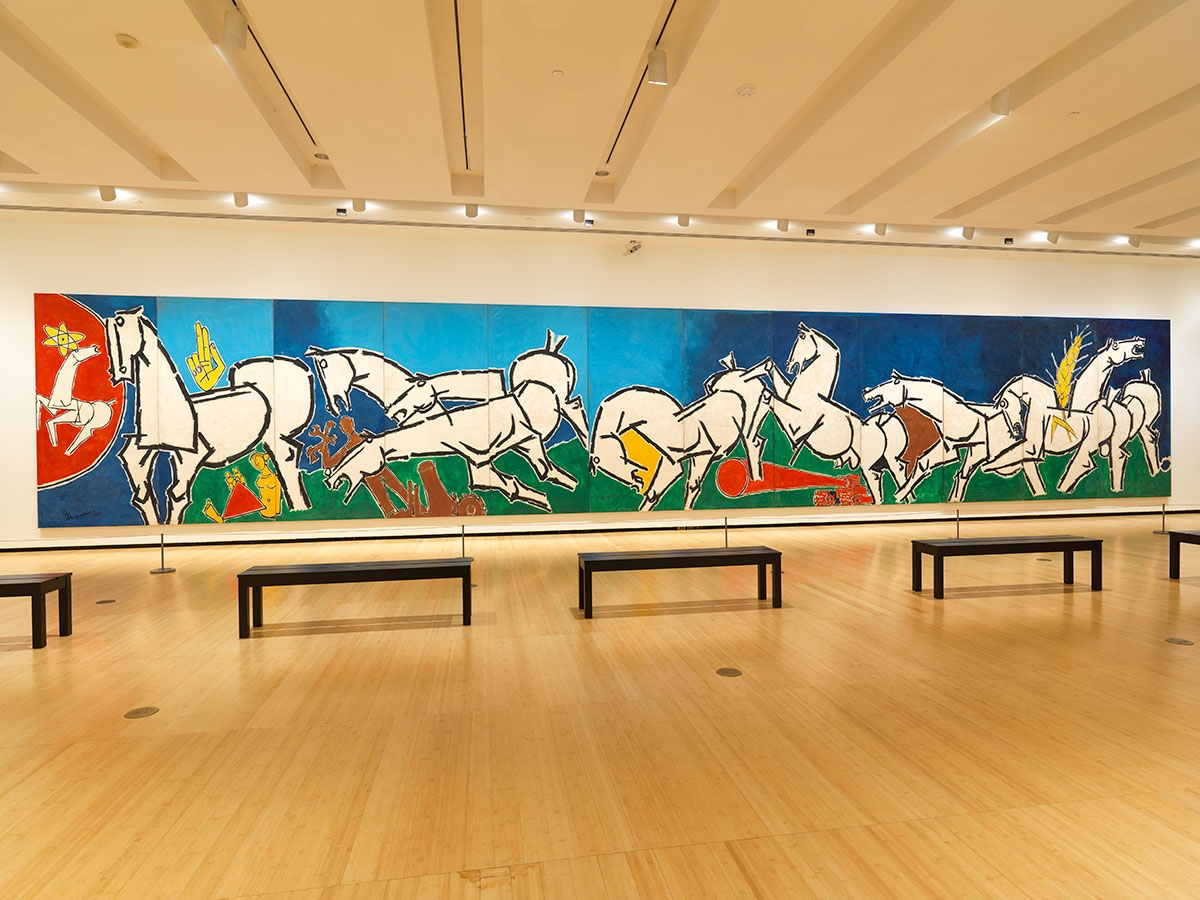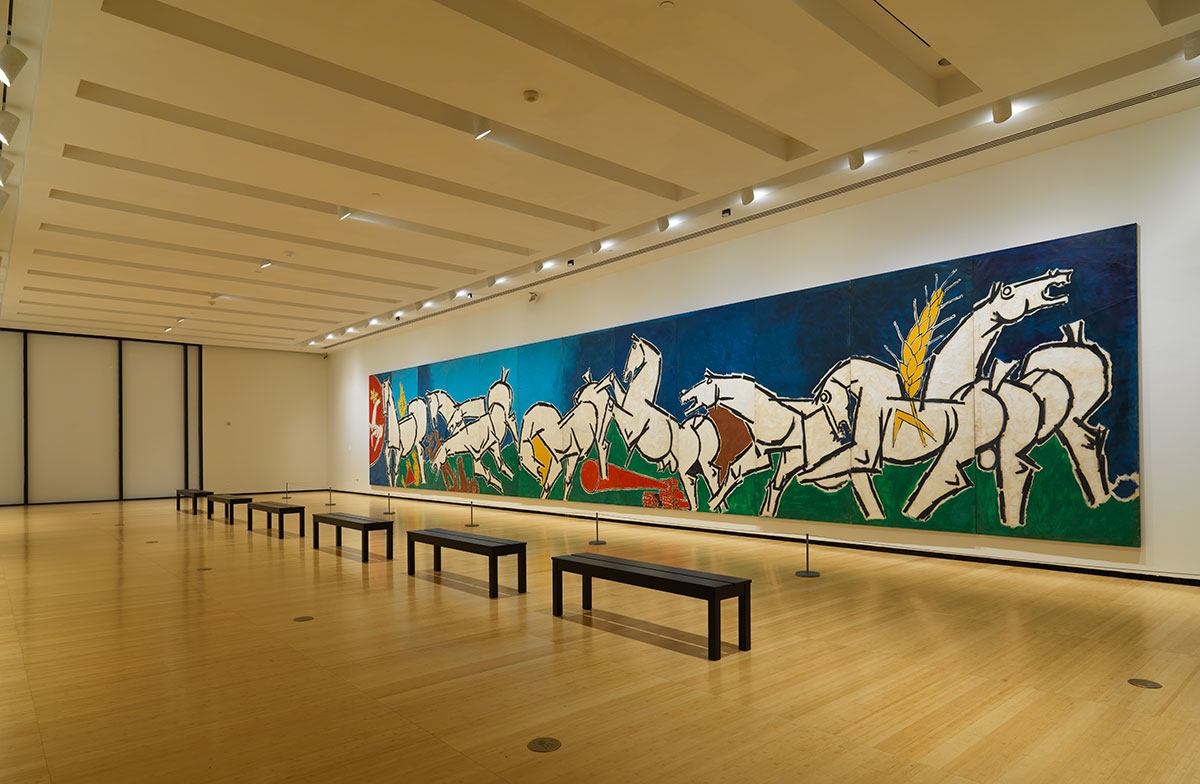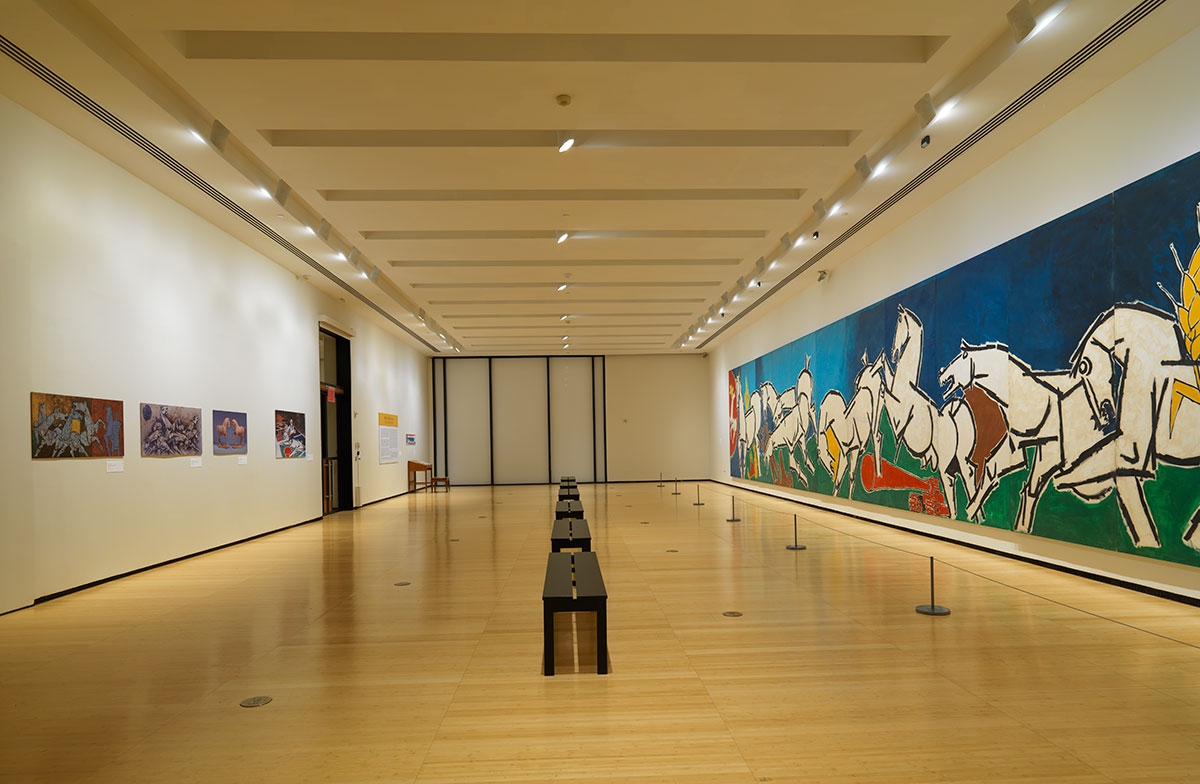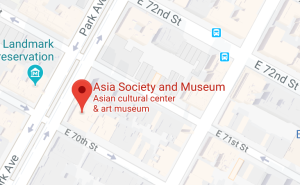
One of the founding members of the Bombay Progressive Artists' Group, M.F. Husain, created the mural-sized painting Lightning for then Prime Minister Indira Gandhi’s Congress Party public rally in 1975 in Bombay (Mumbai), the same year that a state of emergency was imposed across India. The twelve massive panels of Lightning are littered with visual references to India and the 1970s, and though absent visually, to Indira Gandhi. Ironically, by the 1970s, Husain’s alignments with the political leader resulted in the loss of support of some members of the intelligentsia and artistic community. In the following decades, the rise of the Hindu right closed off the artistic strategies that made Lightning possible for Husain, ultimately leading to his exile from India.
M.F. Husain, a founding member of the Bombay Progressive Artists' Group, created the mural-sized painting Lightning on the occasion of Prime Minister Indira Gandhi’s 1975 Congress Party public rally at Shivaji Park in Bombay, or Mumbai, as it is now known. On June 25 of that year, Prime Minister Gandhi imposed a state of emergency across India in response to what she perceived as a state of dangerous instability in the country. The order suspended elections, curbed civil liberties, and granted Gandhi the authority to rule by decree until March 21, 1977, when she was voted out of power. That Lightning was created in this tumultuous period of India’s history, positions Husain at the center of Indian modernism and elicits discussions about the role of art in shifting political contexts.
Husain created Lightning as part of a series of paintings about Indira Gandhi, which he continued even after her assassination in 1984. Under her tenure as Prime Minister, India became a regional power. Ironically, by the 1970s, Husain’s alignment with the political leader resulted in the loss of support from some members of the intelligentsia and artistic community critical of Gandhi’s leadership. In the following decades, the rise of the Hindu right ultimately resulted in Husain’s exile from India, the land of his birth, and in this context, Lightning evokes conversations about the public’s ability to separate a work of art from the physical body of the artist.
M.F. Husain: Art and the Nation follows Asia Society Museum’s recent exhibition The Progressive Revolution: Modern Art for a New India, which focused on the 1930s–1960s. The current exhibition, which showcases the development of Husain’s post-1960s work, is a rare opportunity to see a work that is profoundly defined by its historical context. Lightning provides a way to consider the relationship between art and the nation by examining the role of the artist within society and politics in post-colonial Asia. The work is in many ways a reminder of the complex and sometimes difficult position that can confront an artist who adopts a specific political stance in the face of historical change.
The bold, graphic style of this work indicates that Husain drew upon his experience as a former professional movie billboard painter to create Lightning’s twelve massive panels. These panels, which are each ten feet high and five feet wide, feature much of the visual iconography that defined Husain’s attempts to depict the complexity and richness of new India. Against a background of green, red, blue, and purple, white horses outlined in black charge in an energetic and frenetic line toward the left, as if indicating the unstoppable progress of the new nation. The painting is filled with visual references to India in the 1970s and, most interestingly, allusions to Indira Gandhi, who was at the center of many of the challenges and controversies facing India at the time. The grain stalk seen towards the right references India’s Green Revolution from 1967 to 1978 that was initiated by the Prime Minister in an attempt to make the nation self-sufficient in grain production. At left, the mother with her two young children marked with a red triangle denotes India’s family planning policies, which included mass, forced sterilization under the state of emergency. The historic shadow of this alarming detail adds to the work’s narrative power and grounds it in a specific context. Other visual references in Lightning evoke the country’s industrial and military ambitions. For instance, the horse at far left is framed by the red sun of atomic power, a sign of the new nation’s technological promise of nuclear energy. The plethora of contemporary references is juxtaposed with the image of the horse, which Husain modeled after historical prototypes: the horse from Tang Dynasty tomb pottery and the ink paintings of twentieth-century Chinese master Xu Beihong. Husain greatly admired the energy and spirit of Xu Beihong’s paintings, and the line of horses rearing and charging across Husain’s canvas is equally dynamic and full of life.
Artist Biography
Maqbool Fida Husain was born in 1915 in Pandharpur, Maharashtra, India. He was a founding member of the Progressive Artists’ Group and an internationally-recognized artist at the center of Indian modernism. He was awarded the Padma Bhushan in 1973 and the Padma Vibhushan in 1991, two of the highest civilian honors, by the government of India. Beginning in January 2006, Husain entered self-imposed exile. He was forced out of India by threats from extremists enraged by his paintings of nude Hindu goddesses. He accepted Qatar’s offer of citizenship in 2010 and died in exile in London in 2011.
MF Husain in Conversation with Marguerite Charugundla– an Insight into Lightning
MC: As an artist working over the years with over a thousand paintings to your credit, where would you place “Lightning” in terms of your achievement as a painter – would you call it one of your masterpieces?
MF Husain: The spark of Lightning still holds today as you look at the painting (Lightning). The day I began the work the very same night I completed it – just like lightning! While I painted, my son helped me with mixing paints and getting my brushes together. It was to be displayed the next day. It was a lot of work and extremely exhausting to paint in such a large scale in such short period of time. It was not the first time that I was painting in large scale, prior to this I had painted canvases that were 20 – 30 feet long, however, it was the limited time that I had to complete this painting that made it physically extremely laborious. While I painted it seemed like the painting had possessed me and I was not going to stop until I finished it.
MC: What inspired you to paint horses?
MF Husain: Horses are a childhood fascination for me. There is a festival called Muhallam based on a battle that was fought 1400 years ago in Iraq; it is very similar to the Mahabharata epic. The Prophet’s grandson fought this battle riding his horse named Duldul. Every year during the time of this festival we read the text and sang it like a ballad – this left a very strong image in me that I am still carrying to this day. One comes across similar references in Vedic religion as well where a horse is sent for Ashwamedha. There are so many different stories in history related to horses from varied cultures.
Horses are beautiful animals – I see them in two parts – the front, which is forceful and triumphant, and the back graceful like a woman. It could be regarded as a mix of power and grace; that is how I depict my horses – charging like a dragon in the front and graceful and elegant from the back.
MC: Was “Lightning” commissioned to you for any particular event?
MF Husain: Lightning was not a commissioned work. On completion of 11 years of her primeministership, Indira Gandhi was addressing a current situation in Bombay. The meeting was to be held in Shivaji Park at Dadar. I painted Lightning as a backdrop to this meeting, which was my contribution toward the cause. I chose to depict 11 horses signifying the time and they stand for nuclear power, which was the future of our country. Thus the painting was displayed at Shivaji Park and after the event it was returned to me. This also explains the scale of the work since it was a huge open space for which the backdrop was designed. A Conversation with Husain
MC: Could you share your experience, as an artist how it felt to be painting in such large scale – was it liberating?
MF Husain: I like to work on large scale – this gives one the opportunity to depict tremendous energy force; the overwhelming power can get projected onto the canvas. During the celebration of 100 years of struggle for freedom, which Gandhiji had fought non-violently against the British, I painted a 100 feet long canvas in separate panels as a celebration of this great event. I was so excited to be a part of this celebration and so happy for my country and myself; this painting was my contribution towards this celebration. At times like this you don’t wait for anyone to commission you to do a work; you just do it because you want to do it. Finally when Rajiv Gandhi became the Prime Minister, a huge hall was built in Delhi to celebrate the 100 years of struggle for freedom and I presented this work, which is now on display there.
Even to this day I volunteer my work for any historical or cultural event of significance and or public place like the museums where the public can see the work and it is not hidden away in somebody’s house. I enjoy working on the walls in large scale for museums and similar institutions and prefer not to work on canvas since one can roll a canvas and sell it.
MC: Do you have a preference when you paint: large over small canvases?
MF Husain: The principal is the same whether you do a small painting or a big one. Scale becomes an important factor when you are addressing the masses. For example the stain glass windows in churches are large scale because there are so many people in a church and each one is able to view it simultaneously. Similarly, if one does a work at a station where millions of people commute one has to do the work in large scale so that each one as they pass by can see it and enjoy it. Not everyone has time to go to museums and at least this way they can appreciate an artwork as they pass by. So, scale here is very important so that one is able to view the painting from a distance.
MC: Have you worked on large paintings of this scale since “Lightning”?
MF Husain: Yes, indeed I have. After the Lightning I painted the Hundred Years of Struggle for Freedom and then I painted the Vision of the 20th Century which is more than 40 feet in length and they are in panels so it is easy to transport. I have exhibited this painting in Dubai about three-four years back.
MC: There are several symbols that are embedded in “Lightning”, for example – the red triangle, the farmer / mechanic with tools, the cannon etc. What do these signify?
MF Husain: This is again the depiction of the progress that India is making in agriculture and defense. The tank symbolizes the struggle for freedom and the family planning also is a sign of progress that India embraced.
MC: The overall energy in the horses one sees in these paintings is that of pensive and tense animal force; what is the significance of this brute energy coupled with the symbols?
MF Husain: The strength and energy of the horses come from the larger than life size horses. It is like working on a large statue or a monument, it is always done larger than life size so it looks grand and it is visible from a distance.
MC: Where was “Lightning” exhibited prior to TamarindArt?
MF Husain: It was first exhibited in Bombay. In the 1980’s there was a theater group in Delhi who wanted to use this painting as a backdrop for one of their plays so I lent it to them to use.
MC: Would you consider painting in such large scale in the future?
MF Husain: I am working on one painting here in Dubai, the Vision of the 20th Century which will comprise of about 40 to 50 panels. I have completed 25 panels so far. I have exhibited these here in Dubai. There is another one I am working on which is called Al Arab. Here I am trying to capture the vision of the Arabic civilization and not merely documenting the current situation. The vision may be compared to what is happening in Dubai today. The progress and the pace at which they are moving ahead are phenomenal. What took Europe 300 years to build; here in Dubai it took them 30 years to build. And it is still under massive construction and planning.
When I came here 4 years back everyone told me why I am going to Dubai, there is nothing in Dubai, it is only money and commerce. I said, no country and no nation could be identified without its culture, so it is bound to happen. And it is happening right now and in a very big way. Even Louvre is coming here to Dubai and Guggenheim museum is building the largest museum in the world. They have all the resources and the vision it takes to make these changes in this part of the world. In another 4 to 5 years it is going to be one of the most important cities in the world. Especially the art scene, which is in Paris, London, New York and Tokyo, will have Dubai as its next destination.
MC: What do you think about the art auction scene?
MF Husain: Now all the auctions are happening in Dubai and since the museums are opening in Dubai I believe that art is going to be booming here. Indian art has become a very significant movement. That is why 4 years back I decided to come to Dubai and build my museums. So far I have built 4 museums in India and now I have built 2 museums in Dubai.
MC: What is the significance of the “Lightning” in your life?
MF Husain: Lightning is pure energy – it is a tremendous force – the life force. In the painting it is more to do with the power of the physical world. As an artist after a while you do not struggle to paint a good painting or worry over the language of painting – you go beyond that, and then what you do is you are painting history.
“A Conversation with Husain: MF Husain in Conversation with Marguerite Charugundla—An Insight Into Lightning.” Originally published in Lightning: From the Private Collection of Marguerite and Kent Charugundla, Marguerite Charugundla, (TamarindArt, 2007). Reprinted with permission.



Installation Views of M.F.Husain: Art and the Nation at Asia Society Museum, 2018. Photographs © Bruce M. White, 2019.
Generous support for M.F. Husain: Art and the Nation is provided by Samir A. Gandhi and Anita D. Khushalani.
Support for Asia Society Museum is provided by Asia Society Global Council on Asian Arts and Culture, Asia Society Friends of Asian Arts, Arthur Ross Foundation, Sheryl and Charles R. Kaye Endowment for Contemporary Art Exhibitions, Hazen Polsky Foundation, Mary Griggs Burke Fund, Mary Livingston Griggs and Mary Griggs Burke Foundation, New York State Council on the Arts, and New York City Department of Cultural Affairs.



